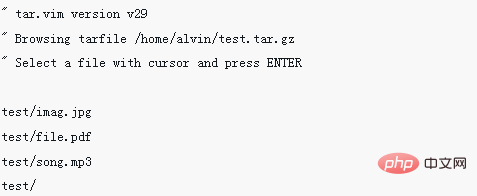 Operation and Maintenance
Operation and Maintenance
 Linux Operation and Maintenance
Linux Operation and Maintenance
 How to display compressed file information in linux
How to display compressed file information in linux
How to display compressed file information in linux
Display method: 1. Use Vim editor, syntax "vim compress file"; 2. Use "tar -tf compress file" command; 3. Use "rar v compress file" command; 4. Use " unrar l compress file" command; 5. Use "zip -sf compress file" command; 6. Use "unzip -l compress file" command; 7. Use "zipinfo compress file" command; 8. Use "zcat compress file" command. ; 9. Use "zless to compress files"; 10. Use less.

#The operating environment of this tutorial: linux7.3 system, Dell G3 computer.
10 ways to view the contents of compressed files under Linux
Generally speaking, when we view the contents of archived or compressed files, we need to decompress them first and then view them. ,kind of hard. Today I will introduce to you 10 different methods that allow you to easily view the contents of archived or compressed files without decompressing them.
Technically speaking, it is not possible to view archived or compressed files without decompressing them in advance. In the method introduced in this article, these compressed files will be decompressed in a temporary directory /tmp in the background. After restarting the system, the contents of the /tmp directory will be cleared.
Before discussing further, here is an explanation of archives and compressed files.
-
Archivingis the process of combining multiple files or folders into one file. In this case, the resulting file is not compressed. -
Compressionis a result file obtained by combining multiple files or folders into one file and compressing them.
Archived files are not compressed files, but compressed files can be archived files. After understanding these two concepts, we formally introduce how to view the contents of compressed files without decompressing them.
1. Use the Vim editor
Vim is not just an editor, it also contains many other powerful functions. The following command will directly display the contents of the compressed archive file:
$ vim test.tar.gz

Not only that, using Vim you can even browse the archive file directly, if there is Text file, you can also open it directly, which is very convenient.
If you need to open a text file, just use the arrow keys to move the cursor in front of the file and press the ENTER key. Can be opened
2. Use tar command
tar command can not only be used to compress/decompress files, but also When extracting the tar file, use the tar -tf command to view the contents of the compressed package.
$ tar -tf test.tar
Alternatively, use the -v option to view detailed properties of the archive file, such as permissions, file owner, group, creation date, etc.
$ tar -tvf test.tar
3. Use the rar command
Similarly, without extracting the rar file You can use the rar v command to view the contents of the compressed package.
$ rar v test.rar
4. Use the unrar command
For the above rar file, you can also use The unrar command with l parameter views the contents of the rar file.
$ unrar l test.rar
5. Use zip command
Can be used without extracting the zip file zip -sf command to view its contents.
$ zip -sf test.zip
6. Use the unzip command
is similar to unrar, use the -l parameter unzip command to view the contents of the zip file.
$ unzip -l test.zip
7. Use the zipinfo command
to view the contents of the zip file. You can also use zipinfo command, execute the zipinfo command to get the detailed information of the zip compressed file.
$ zipinfo test.zip
zipinfo -v haicoder.zip
8.使用 zcat 命令
使用 zcat 命令查看归档/压缩文件。
$ zcat test.tar.gz
zcat 与 gunzip -c 命令功能相同。因此,你还可以用下面的命令:
$ gunzip -c test.tar.gz
9.使用 zless 命令
使用 zless 命令查看归档/压缩文件。
$ zless test.tar.gz
zless 类似于 less ,它可以逐页显示内容。
10.使用 less 命令
less 命令大家都可能有所了解了,它能以交互的方式查看文件内容。不仅如此,它还可以用来查看归档/压缩文件的内容:
$ less test.tar.gz
相关推荐:《Linux视频教程》
The above is the detailed content of How to display compressed file information in linux. For more information, please follow other related articles on the PHP Chinese website!

Hot AI Tools

Undresser.AI Undress
AI-powered app for creating realistic nude photos

AI Clothes Remover
Online AI tool for removing clothes from photos.

Undress AI Tool
Undress images for free

Clothoff.io
AI clothes remover

Video Face Swap
Swap faces in any video effortlessly with our completely free AI face swap tool!

Hot Article

Hot Tools

Notepad++7.3.1
Easy-to-use and free code editor

SublimeText3 Chinese version
Chinese version, very easy to use

Zend Studio 13.0.1
Powerful PHP integrated development environment

Dreamweaver CS6
Visual web development tools

SublimeText3 Mac version
God-level code editing software (SublimeText3)

Hot Topics
 1664
1664
 14
14
 1421
1421
 52
52
 1315
1315
 25
25
 1266
1266
 29
29
 1239
1239
 24
24
 Linux Architecture: Unveiling the 5 Basic Components
Apr 20, 2025 am 12:04 AM
Linux Architecture: Unveiling the 5 Basic Components
Apr 20, 2025 am 12:04 AM
The five basic components of the Linux system are: 1. Kernel, 2. System library, 3. System utilities, 4. Graphical user interface, 5. Applications. The kernel manages hardware resources, the system library provides precompiled functions, system utilities are used for system management, the GUI provides visual interaction, and applications use these components to implement functions.
 How to check the warehouse address of git
Apr 17, 2025 pm 01:54 PM
How to check the warehouse address of git
Apr 17, 2025 pm 01:54 PM
To view the Git repository address, perform the following steps: 1. Open the command line and navigate to the repository directory; 2. Run the "git remote -v" command; 3. View the repository name in the output and its corresponding address.
 vscode Previous Next Shortcut Key
Apr 15, 2025 pm 10:51 PM
vscode Previous Next Shortcut Key
Apr 15, 2025 pm 10:51 PM
VS Code One-step/Next step shortcut key usage: One-step (backward): Windows/Linux: Ctrl ←; macOS: Cmd ←Next step (forward): Windows/Linux: Ctrl →; macOS: Cmd →
 How to run java code in notepad
Apr 16, 2025 pm 07:39 PM
How to run java code in notepad
Apr 16, 2025 pm 07:39 PM
Although Notepad cannot run Java code directly, it can be achieved by using other tools: using the command line compiler (javac) to generate a bytecode file (filename.class). Use the Java interpreter (java) to interpret bytecode, execute the code, and output the result.
 What is the main purpose of Linux?
Apr 16, 2025 am 12:19 AM
What is the main purpose of Linux?
Apr 16, 2025 am 12:19 AM
The main uses of Linux include: 1. Server operating system, 2. Embedded system, 3. Desktop operating system, 4. Development and testing environment. Linux excels in these areas, providing stability, security and efficient development tools.
 How to run sublime after writing the code
Apr 16, 2025 am 08:51 AM
How to run sublime after writing the code
Apr 16, 2025 am 08:51 AM
There are six ways to run code in Sublime: through hotkeys, menus, build systems, command lines, set default build systems, and custom build commands, and run individual files/projects by right-clicking on projects/files. The build system availability depends on the installation of Sublime Text.
 laravel installation code
Apr 18, 2025 pm 12:30 PM
laravel installation code
Apr 18, 2025 pm 12:30 PM
To install Laravel, follow these steps in sequence: Install Composer (for macOS/Linux and Windows) Install Laravel Installer Create a new project Start Service Access Application (URL: http://127.0.0.1:8000) Set up the database connection (if required)
 git software installation
Apr 17, 2025 am 11:57 AM
git software installation
Apr 17, 2025 am 11:57 AM
Installing Git software includes the following steps: Download the installation package and run the installation package to verify the installation configuration Git installation Git Bash (Windows only)











